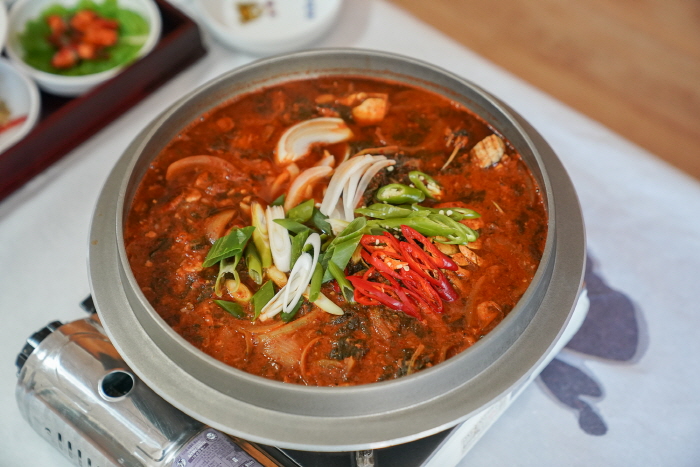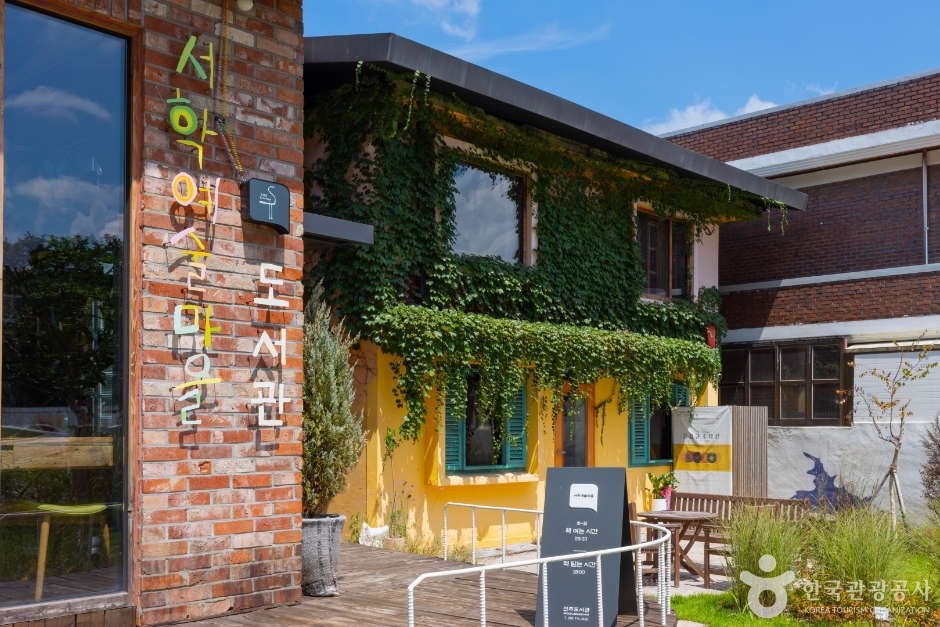Gimje Munsusa Temple (문수사(김제))
12.8 Km 9349 2024-04-07
158, Hwangsan 5-gil, Gimje-si, Jeonbuk-do
+82-63-547-0972
Munsusa Temple, located in Hwangsan-dong, Gimje, is a branch temple of Geumsansa Temple. The temple is located in the heart of nature atop Bonghwangsan Mountain (alt. 100 meters), which is surrounded by the seemingly endless Mangyeong Plains. The temple was built by the great monk Hyedeok Seonsa in the 25th year of King Mu of Baekje after he was visited in his dreams by Munsu Bosal (a Buddhist Saint). The temple was named ‘Munsu’ after ‘Munsugol,’ the original name of the neighborhood in which the temple is located.
In front of the temple stands an ancient zelkova tree whose giant girth measures well over 5 meters. The tree, which is called gwimok (meaning holy, miraculous tree), was recently designated a specially protected tree and is now the focus of preservation efforts. Every January 14th (according to the lunar calendar), local lovernment of Gimje holds a sacred ritual for the tree while the temple holds a ritual to honor the mountain spirit.
Daeiljung (대일정)
12.8 Km 16750 2024-04-07
3 Suhakjeongseok-gil, Taein-myeon, Jeongeup-si, Jeonbuk-do
This Korean restaurant prides itself on serving an abundant Korean set meal, notably featuring the marinated hairy crab set menu and the grilled galbi patties set menu. Each set is accompanied by a lavish selection of 20 different side dishes. The marinated hairy crab, a seasonal delicacy, involves small river estuary crabs prepared in a savory sauce of green onions, red pepper paste, and soy sauce, ideally mixed with white rice. The grilled galbi patties, a harmonious blend of beef and pork, are grilled to perfection, offering a savory taste and a rich, juicy gravy. To conclude one's meal, enjoy a comforting serving of warm scorched rice soup and plum tea, which provides a gentle, soothing end to the rich flavors. Here, one can indulge in the full spectrum of sophisticated Korean cuisine.
Seohak Art Village Library (서학예술마을도서관)
12.8 Km 0 2024-04-06
12-1 Seohak-ro, Wansan-gu, Jeonju-si, Jeonbuk-do
Seohak Art Village Library opened June 2022 in Jeonju, Jeollabuk-do. The library consists of nearly 1,000 books, making it rather small. However, the library makes up for its size with pretty decorations, making visitors want to stay longer. The library is located in an old building that was previously a cafe and gallery, so the library feels more like a book cafe.
Jeonju Nambu Traditional Market (전주 남부시장)
12.8 Km 41911 2024-04-06
63, Pungnammun 2-gil, Wansan-gu, Jeonju-si, Jeonbuk-do
+82-63-284-1344
Jeonju Nambu Traditional Market opened as a regular public market in 1905 at the site of the Joseon-era Nammunbakk Market, located just outside the Southern gate to the city. Currently the market is comprised of about 800 stores with 1,200 workers selling vegetables, fruits, food, dried fish, furniture, silk goods, and general goods.
The market was revitalized with the creation of the Youth Market, located in the previously empty shops on the second floor of 6-dong. An influx of young shopkeepers and entrepreneurs has given the marketplace an exciting vibe like that found in Hongdae or Samcheong-dong.
The night market held on Fridays and Saturdays also draws in many visitors with a multitude of delicious treats, ranging from traditional dishes such as nokdujeon (mung bean pancake) to fusion treats like bibimbap served in rice paper like a spring roll.
Bangjjanotjeon [Tax Refund Shop] (방짜놋전)
12.9 Km 0 2024-04-22
28, Pungnammun 4-gil, Wansan-gu, Jeonju-si, Jeollabuk-do
-
Namcheongyo Bridge Cheongyeonru (남천교 청연루)
13.0 Km 21386 2024-04-07
40 , Cheongyeong-ro, Wansan-gu, Jeonju-si, Jeonbuk-do
+82-63-281-5361
Namcheongyo Bridge is the main bridge to the entrance of Jeonju Hanok Village. Through "Jeonju Namcheongyo Luxury Project," the area went through renovation strengthening infrastructure and adding Cheongyeonru Pavilion to the bridge. Visitors can enjoy a panoramic view of the area from the hanok pavilion or rest from the heat.
Jeondong Catholic Cathedral (전주 전동성당)
13.0 Km 52000 2024-04-07
51 Taejo-ro, Wansan-gu, Jeonju-si, Jeonbuk-do
Jeondong Catholic Cathedral in Jeonju (Historic Site) was built in honor of Roman Catholic martyrs of the Joseon dynasty on the very same spot the martyrs lost their lives. The land was purchased by French Priest Baudenet in 1891 (28th year of King Gojong), but construction of the church did not begin until 1908. The church was designed by Priest Poinel, who also designed the famous Myeongdong Cathedral in Seoul. Construction was completed in 1914, a time during which Korea was under Japanese rule. Though originally built just outside of Pungnammun Gate, the site of the martyrs, the church was later moved to its current location for expansion.
The first Romanesque building in the Honam region, Jeondong Catholic Cathedral is made of gray and red bricks and bears a striking resemblance to the Myeongdong Cathedral in Seoul. Not only considered one of the most beautiful Catholic churches in Korea, some even go so far as to say it is one of the most beautiful structures in all of Korea, citing the church’s unique combination of Byzantine and Romanesque architectural styles. The rectangular building is topped with three Byzantine bell towers (to the right, center, and left) and boasts arched ceilings, several of which meet in the form of a cross.
It is interesting to note that some of the bricks used in construction of the church were made using materials from the Jeonjueupseong Walled Town, which was torn down by the Japanese. It is also said that the cornerstone of the church came from a wall of Jeonjueupseong Walled Town near Pungnammun Gate.
Hanok Garden in Jeonju [Korea Quality] / 전주한옥마당 [한국관광 품질인증]
13.0 Km 251 2024-04-07
80-13 , Jeonjucheondong-ro, Wansan-gu, Jeonju-si, Jeonbuk-do
+82-10-9494-4579
Jeonju Hanok Garden in Jeonju Hanok Village, Jeollabuk-do, is a guesthouse combining traditional hanok charm with modern comfort. All guestrooms have a modern bathroom and toilet and a toenmaru wooden porch, while two rooms (Hope and Faith) have an additional inner floors attached to it. The room interiors have exposed wooden beams and hanji-covered walls and doors. From any room, guests enjoy a view of the beautiful yard with its jangdokdae jar store, flower pots and young pine trees.
Jeonju Pungnammun Gate (전주 풍남문)
13.0 Km 29321 2024-04-07
1, Pungnammun 3-gil, Wansan-gu, Jeonju-si, Jeonbuk-do
+82-63-287-6008
Pungnammun Gate was built during the Joseon dynasty in 1734 and is a designated Treasure. Pungnammun Gate was the southernmost gate among the four city gates of Jeonju. The structure was severely damaged by fire in 1767, followed by the restoration of the gate tower afterward. The gate was burnt down once again during the Imjin War and was restored to the gate that is seen today.
Hanokhyeyum [Korea Quality] / 한옥혜윰 [한국관광 품질인증]
13.0 Km 103 2024-04-07
42-5 , Hyanggyo-gil, Wansan-gu, Jeonju-si, Jeonbuk-do
+82-10-5512-1226
Hanok Hyeum on Hyanggyo-gil, Jeonju-si, Jeollabuk-do, is a hanok stay with seven ondol guestrooms. It exemplifies traditional hanok style and has a small window that captures the sunlight, lending a bright, quiet and cozy atmosphere. Jeonjucheon Stream flows past the hanok, and a walk along the path that follows it is highly recommended. Jeonju Hyanggyo Confucian School is a 3-minute walk away. The sunset and night views from the Cheongyeonnu Pavilion atop Namcheongyo Bridge are beautiful: take a photo!





![Hanok Garden in Jeonju [Korea Quality] / 전주한옥마당 [한국관광 품질인증]](http://tong.visitkorea.or.kr/cms/resource/43/2594443_image2_1.png)

 English
English
 한국어
한국어 日本語
日本語 中文(简体)
中文(简体) Deutsch
Deutsch Français
Français Español
Español Русский
Русский